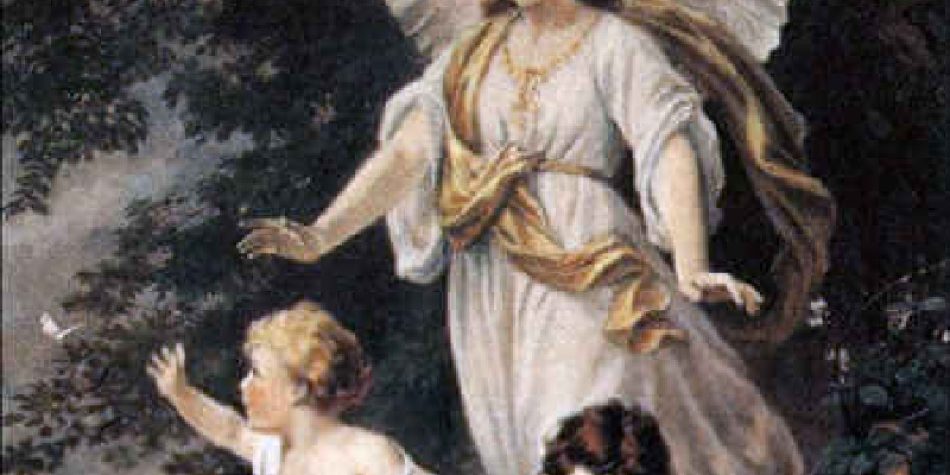One of the great frustrations of my academic career, now spanning four decades, has been the number of “guardian angel theories” that I have encountered. Opposing and undoing them is very hard work, not because the logic and conceptual work are difficult, but because the guardian angels are conceived and maintained for mostly emotive, political, and otherwise self-serving reasons. Such motivations make it difficult for people to examine or critique the theory openly and transparently.
A “guardian angel” theory is one that is self-referential, relies on itself to prove itself, and has built-in mechanisms acting to protect a theory from critique. In other words, the claims and constructs of the theory are invoked to defend itself against any criticism of the claims and constructs of the theory. The result is that the theory insulates itself from any valid criticism of the theory because all criticism is preempted and explained away by the language of the theory itself. It is, thus, untouchable and, in the eyes of its adherents, therefore, always safe from criticism. Examples are provided below.
Being a social scientist, I have always worked in what might be called a “target-rich” intellectual environment. There are always new guardian angel theories popping up. Freudian Psychoanalytic Theory may be the best-known example. It works like this: The theory gives the expert (analyst) the real account of the meanings and causes of the client’s behavior which the analyst then shares with the client. If the client objects to or rejects the explanation, it just simply means—to the expert analyst—that the client knows the account is true but resists it. He or she has simply repressed the truth that the theory claims and is in denial. The stronger the client’s resistance to the analyst’s explanation, the more certain the expert is that they are right, and the resistance itself is proof of the rightness of the theoretical account. So the theory is irrefutable, especially by the person whose behavior is being explained by the theory. Even if an outside scholar should offer a spirited refutation of repressions or denial and the whole theory behind it, it is possible to reduce that scholar’s motives and argument to simple repression denial at the cultural level, and thus it provides all the more evidence that the theory is true. This is one reason psychoanalysis has lasted as long as it has. It is basically irrefutable—thanks to the guardian angel—which assumes the form of unconscious repression and denial.
Guardian angel theories are deeply appealing.
Guardian angel theories are deeply appealing and, as a result, are easy to find. When a theory has a guardian angel, it is easily mastered and thus quite simple in form. After all, if one has a guardian angel, one need not be too sophisticated or careful—the “angel” will always bail you out. And if the theory is to enjoy longevity, it can rely on factors such as sheer volume of material produced, passion engendered, mass appeal, political exigency and power, and such strategies as simplicity of the message—i.e., slogans.
Thus, the latest craze in guardian angel theories really isn’t new. Guardian angel theories are generally pretty simple in structure. Most follow the basic template. The newest and loudest guardian angel theory of our time is Critical Race Theory (CRT)—and various theories parasitic on it, and thus often even less developed. CRT itself is parasitic on 19th-century philosophical perspectives.
The genealogy of CRT is quite easy to trace from its roots in the nineteenth century. Positivist social science, which rejected the role of ethics, aesthetics, metaphysics, and even epistemology in understanding human behavior, was combined with the thought of the “Young (Left) Hegelians,” who believed the purpose and nature of history was the overcoming and supplanting everything that restricted freedom. And the movement seemed to focus, perhaps, particularly on the threat to freedom posed by religion. The famous Marxist one-liner that can be paraphrased is: Religion is the opiate of the masses. Marxism has a guardian angel that served it well for the better part of two centuries. Especially perhaps, in those nations that have been officially Marxist during show trials and crackdowns. Anyone who cannot see the advantages and the inevitable rightness of a Marxist system of economy and government is “reactionary,” i.e., an counter-revolutionary. The guardian angel proclaims that, as such, opposers of the Marxist account of history and culture are so influenced by an older system that they do not see the advantages and inevitability of the Marxist dictatorship of the proletariat. This all is evidence of the truth of the fundamental tenets of Marxism regarding the oppressive and enslaving nature of the older capitalist/enlightenment system. Thus, any opposing arguments are evidence of the truth and validity of the original position—in this case, the Marsixt position. Persons suffering under the oppression of the old system may very well need to be “re-educated” to think properly. How can it be known that they are reactionary and need to be reoriented? Because they oppose the politico-economic system that Marxism dictates. What is the source of their opposition? They are reactionary. The Guardian Angel works so well that many can be led to see the reasonableness of a slogan such as “Freedom is Slavery.”
After it became clear that the most important experiments with economic Marxism were failures (in the Soviet Union and Eastern Europe), critical theorists regrouped. Economics did not seem to be an adequate cause to produce the energy necessary to sustain the vibrancy and power of the theory and protect it sufficiently to allow the Guardian Angel to do its job. This problem gave rise to what many refer to as “Cultural Marxism.” It is this movement from which CRT and its Critical Theory cousins emerge and through which they can seek shelter under the wings of the guardian angel they need.
Any opposing arguments are evidence of the truth and validity of the original position.
Concentrating on CRT, it is easy to find the Guardian Angel. The leading lights of the movement make it almost too easy. The Guardian Angel is a species of “false consciousness” argument. It takes the form of a requirement that any evaluation, or even opposition, that does not endorse the fundamental tenets of “Anti-Racism” as articulated is racist. And lack of support for these approved tenets is ipso facto racist. And the opposition is attributed to false consciousness. Someone can abhor harm, unfairness, and differential benefits and oppose them in any number of ways, but for CRT, this is not enough because CRT requires that, in addition to any nonracist activities one may engage in and how one may feel in one’s very soul, one must not be just non-racist, but Anti-racist. Conveniently, being anti-racist is defined as being accepting and supportive of the origin story that CRT offers regarding history and all things racist. So anyone who raises questions about the orthodox historical, anthropological, economic, philosophical, and analytical story of racism currently promoted is ipso facto racist. This move saves intellectual and political energy and allows the Guardian Angel to do all the heavy lifting of advocacy and persuasion. It seems not to concern adherents of the theory that their guardian angel is simply employing a mean-spirited ad hominem fallacy.
From a historical perspective, this author gets the sense that Critical Theory scholars are running out of patience. The stakes are higher intellectually. Opposition to the received view of racism, as presented in CRT, means that one is not merely stupid and uneducated but morally deficient—a racist. That is an ideologically powerful move. It makes an otherwise kind, charitable, racially sensitive person who just has a hang-up about Cultural Marxism or the fast and loose history lessons on offer into “a racist,” and no further analysis seems necessary. It is a very convenient thing—both politically and intellectually—to be able to dismiss any objection or opposition summarily with a show-stopping accusation. Not only does a proponent have no need to explain or justify the “theory” part of CRT, but anyone who asks him or her to do so is a racist (game, set, match). This saves time and energy and leaves more time for the important work of value signaling. Many institutions of higher education have caught this spirit—i.e., file all reactions to CRT under “reactionary,” and get on with the project.
One last point deserves mention. One of the most vocal proponents of CRT, Professor Ibram Kendi, has thrust himself into the middle of the religious issue. As a convicted LDS Christian, I feel the need to respond publicly. Two points are salient in my humble Christian witness. First, as a Christian and Latter-day Saint, I need to believe in the reality of individual salvation and individual sin for which it is the cure. A loving Father and God does not send His children for a moral test to a moral proving ground where the only moral terrain is socio-political. He does not send us where socio-historical morality is the real test of our lives and where personal morality can only be considered, at best, a sideshow. My deep concern for personal morality, my sins against particular others who are likewise children of my own heavenly parents, is the crucial issue of my life as a Christian. It is not racist to believe this. It cannot be overcome or overshadowed by larger social issues.

By choice or by default, Professor Kendi has become an important authoritative voice in CRT. His statement about CRT, Racism, Anti-racism, and Christianity can, I believe, be considered representative of the position. It certainly has not engendered opposing statements, disavowals, or even clarifications. It is available here. Professor Kendi declares without clarification or moderation that there are (at least from the perspective of CRT) two types of Christianity: a) Liberation Theology—essentially the Social Gospel perspective from decades past, aimed at revolution and liberation, and b) Savior Theology—to save and heal people from their sins. Savior Theology, Kendi proclaims, is Racist. If Kendi is right, and if his views are representative of mainstream CRT analysis (and in the minds of many, he is right), my Christian choice is clear. I will oppose CRT and trust in the redeeming love of my Savior, not only for me but for the world.
I really do not mind Guardian Angels, perhaps like the one who might have visited Christ in the Garden of Gethsemane to comfort and strengthen Him. But I reject all theories—even broad cultural revolutions that invoke and rely on Guardian Angels. It seems that, in the case of CRT, zeal has blinded our reason and our respect for the moral agency of every human soul.















